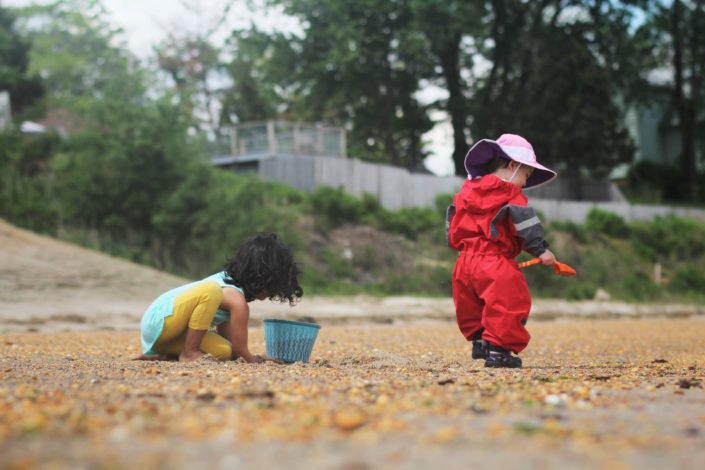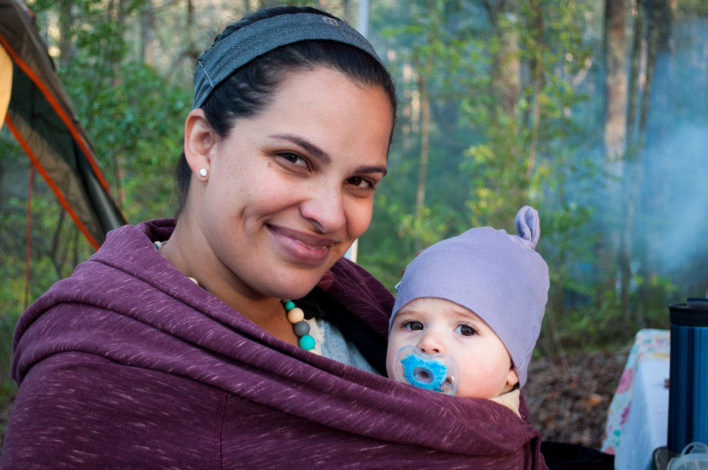Leave No Trace: What does it Mean for kids?
If you'd like to learn more about Leave No Trace, check out the other posts on this topic: Part 1: Plan ahead and Prepare and Part 2: Choosing the Right Path


I lived a fairly simple childhood
I was among a generation of children born from parents who were lucky enough to grow up in the 60's and 70's. Parents who can recall building their very own tree house in the old oak tree. Parents who spent summers playing baseball in the nearby sand lot by day and caught fireflies at night. And, lucky for me, my parents wanted to give me a childhood like they had. They wanted me to savor the simple things. Like a bike ride on a Saturday afternoon to the beach. Each spring on the first nice Saturday, my Dad and I got on our bikes and headed toward the Audubon. Making the 1.5 mile trek down Milford Point to the Coastal Center was something I loved sharing with my dad. Pedaling easily down a maze of tree-lined side streets, we made our way together, singing and laughing until the sky opened up and there was just blue. And salt air. We’d park our bikes in the gravel lot before heading toward the beach. Living in this Connecticut seaside community, we have grown used to the beaches. Which ones to visit with toddlers or which to play volleyball. Which one has a snack bar and which has the best sunset. Our town is lined with beaches from one end to the other, Gulf Beach and Silver Sands, Woodmont and Wildemere.
Still, there was nothing quite like this beach. Our beach.
Buffered by an expanse of sea grass dunes, stretching to the end of the point, the sandbar extends into a curved peninsula, offering a safe haven for shorebirds like piping plover and egrets to nest. I would spend hours combing this shoreline, marveling at all of the seashells glimmering like tiny beach tokens. Oysters and Conch shells, Sea Scallops and Mermaid’s Toenails. Harboring a treasured collection of shells, driftwood and seaglass, this particular beach is part of a nature preserve protected by the Audubon. And, as a protected nature sanctuary, there are boundaries. There are rules. Visitors are asked to leave the beach as they found it, taking nothing with them and leaving no trace.As a kid Leave No Trace was a hard ethic to follow
I would plead with my Dad to let me take just a handful of these shells home with us. I begged to pocket just one piece of the cobalt blue seaglass I had carefully plucked from the mountain of oyster shells. But please Dad, just one little Periwinkle? For the longest time, I couldn’t understand why I wasn’t able to collect these tiny treasures. Surely there were enough? And wouldn’t the tide just wash more ashore in six hours? Only later in life was I able to really understand the phrase, “Take nothing but memories, leave nothing but footprints.” If you tend to spend a lot of time in the great outdoors, whether near the shoreline, in the mountains or in the desert, you’re likely to hear the phrase “Leave No Trace.” What does the three-word slogan really mean? Simply put, it’s the best practices we should follow to enjoy and protect our natural spaces. With well over 100 million visitors on more than 10 billion outings in the U.S. each year, our love for the outdoors can take a toll. Take the collecting seashells. It’s a staple of summer vacation: Head to the beach, pick up a few seashells, and take them home as keepsakes.What’s the problem with taking a few shells?
Well, if you multiply this harmless little beach activity by trillions, we’ve got a serious global problem on our hands. With skyrocketing numbers of beachcombers pocketing seashells come increased environmental implications ranging from increased erosion to fewer building materials for bird nests. Seashells, believe it or not, play an important role in ecosystems. They are shelter for algae, building materials for birdnests, and armor for hermit crabs. Sure, we want our kids to explore the outdoors, play in the mud, climb trees and build forts, but there are too many heavily used and environmentally sensitive areas that need our protection. Teaching our children the Leave No Trace will help instill a lifelong respect for nature and develop environmental awareness and action in the next generation. Take your kids outside. Lead by example. And teach these lessons every chance you get. You’re changing the world, together, with your kids.
Leave No Trace Tips for Kids
Know Before You Go
As a kid, you often don’t have a lot of choices. Finding opportunities to give your child a choice helps build buy-in and confidence. How does this apply to Leave No Trace? When planning your outdoor adventure, have your child research the weather forecast and plan the best clothing to wear, provide trail choices, and allow them to choose their lunch and snack food for the trip.Travel and Camp on Durable Surfaces: A good camp site is found, not made
Always use established trails and campsites whenever available to avoid trail erosion. Walk in single-file in the middle of the trail, even when wet or muddy and avoid trails where impacts are just beginning. Encourage your children’s imaginations while directing their powers of awareness and conscious foot-stepping with the power of role-playing. Try a game of secret spies to teach children to leave no evidence of where they have been. Parents, you can play “detective” to follow your "ninjas" trails as they navigate the forest remaining unseen and unheard.Pack It In, Pack It Out
Accept the challenge of packing out all trash, leftover food, and litter when visiting the outdoors. Play “I spy” with trash by creating a competition among kids (or between kids and parents) to see who can collect the most litter. This activity gets kids thinking about the accumulation of trash and its impact on parks and communities.Respect Wildlife
Animal encounters are a natural fascination for kids. Help your children understand how to keep a safe distance from wildlife by asking them to stand with one arm raised straight out at shoulder height with their thumb up. Ask them to look at the animal with one eye closed and try to cover it with their thumbs. If they are far enough away, their thumbs will completely block sight of the animal. Quick movements and loud noises are stressful to animals. Teach your child to be a considerate camper. Be sure to store food securely and keep garbage and food scraps away from animals. Never feed wildlife. Keep wildlife wild.Be Careful with Fire
True Leave No Trace fires are small. Use dead and downed wood that can be broken easily by hand. Turn gathering firewood into a fun activity by playing a firewood relay race where the objective is to gather the most dead and downed firewood of appropriate size. Any firewood larger than kids’ wrists cannot be used and be sure to explain that firewood should be no larger in diameter because it takes too long to burn into ash, hindering the decomposition process. Whenever possible, use an existing campfire ring in a well-placed campsite. And even better, consider using a lightweight camp stoves which are fast, eliminate the need for firewood, and make cleanup after meals easier.Leave What You Find
This can be difficult for kids. When your kid discovers a cool rock or finds the perfect hiking stick, it can be really difficult for them to part with at the end of your hike. Try giving your child a camera to take photos of treasures they find on the trail. Create a nature journal, scrapbook or use a photo collage application to encourage creativity and save and share their outdoor adventures. This reinforces that they can keep the memory of their adventure while leaving the objects themselves in nature.Be Kind to Others
Encourage kids to be respectful, courteous and polite when playing outdoors. Model and teach good manners, such as sharing the trail with others and taking breaks away from trails and other visitors and avoid bad behaviors, such as making loud sounds and noises and talking on cell phones. We can teach our children about the natural world. Kids can learn to tell time using a stick and the sunshine. We can take our kids for walks. We can teach them about the seasons. As parents, we can let them play with sticks and climb trees. Watch clouds and gaze at stars. We can teach them to Leave No Trace. Our world depends on it. Do you have any tips on implementing Leave No Trace with your kids? Share with us below! Photos courtesy of Ali Chandra and Melissa HollingsworthRelated Content




Comments